We decided to upgrade the battery on Bob's bike with something special.
We decided to upgrade the 48v (13S7P) battery to a 56v (15S7P) battery using 15 cells in series, but only charging the cells to a maximum of 3.92v. This gives us a maximum voltage of 58.8v maximum which is the voltage of a 52v (51.8v) 14s battery.
The reason for this is to increase the longevity of the battery. It will also have a faster recharge time, as each cell is never charged to its maximum voltage. The nearer the charger gets to 4.2v the slower it charges, so by only charging to 3.92v (93.3% of 4.2v) the battery will be charged much sooner.
Link to Bob's battery 48v 13S7P
We went from a 48.1v (13S7P) 34.3Ah battery to a 51.8v (15s7p) 34.3Ah battery.
You may be saying "But a 52v(51.8v) battery is a 14S (14 in series) !", read below to find out more.
A 48v battery is 13 x 3.7v = 48.1v Nominal voltage with a maximum voltage of 54.6v (13 x 4.2v).
A 52v battery is 14 x 3.7v = 51.8v Nominal voltage with a maximum voltage of 58.8v (14 x 4.2v).
Our 52v 15s battery has a maximum voltage of 58.8v (15 x 3.92v).
Previous battery 48v (13s7p) 34.3Ah (Samsung 21700 50e 4900mAh cells)
48.1v Nominal battery (13 x 3.7v = 48.1v) with a maximum voltage of 54.6v (13 x 4.2v) with cells grouped as 7 cells in parallel.
The 7P is 7 cells in parallel which gives us 4900mAh (4.9Ah) x 7 = 34.3Ah
This gave us 13 cells in series and 7 cells in parallel which gave us total of 91 cells.
Our new battery 52v 15s7p 34.3Ah (Samsung 21700 50e 4900mAh cells)
51.8v Nominal battery (15 x 3.7v = 51.8v) with a maximum voltage of 58.8v (15 x 3.92v) with cells grouped as 7 cells in parallel.
This gave us 15 cells in series and 7 cells in parallel which gave us total of 105 cells.
Normally 15 cells in series would give us 63v (15 x 4.2v)
This is a 52v battery with 15 cells in series with a maximum cell voltage of 3.92v, giving us a maximum voltage total voltage of 58.8v (15 x 3.92v) .
Diagram of old battery (13S7P)

Diagram of the new battery (15S7P)
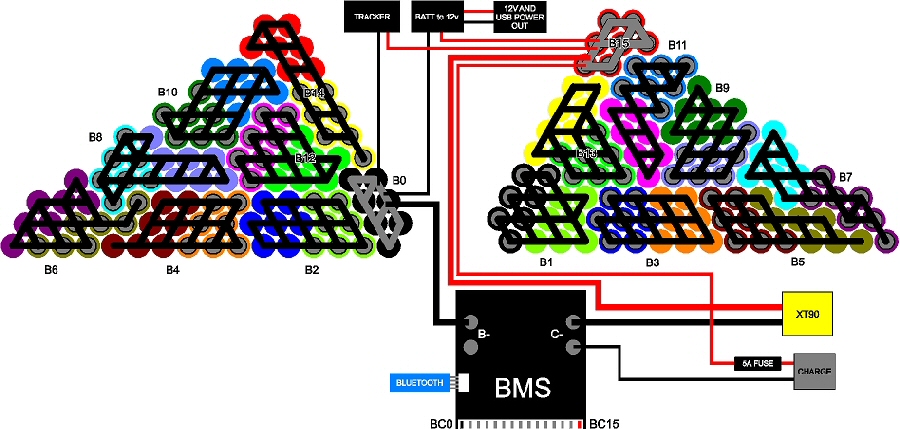
We also upgraded the BMS to a 52v 60 Amp (Continuous) Bluetooth BMS
Battery BMS Connection Diagram

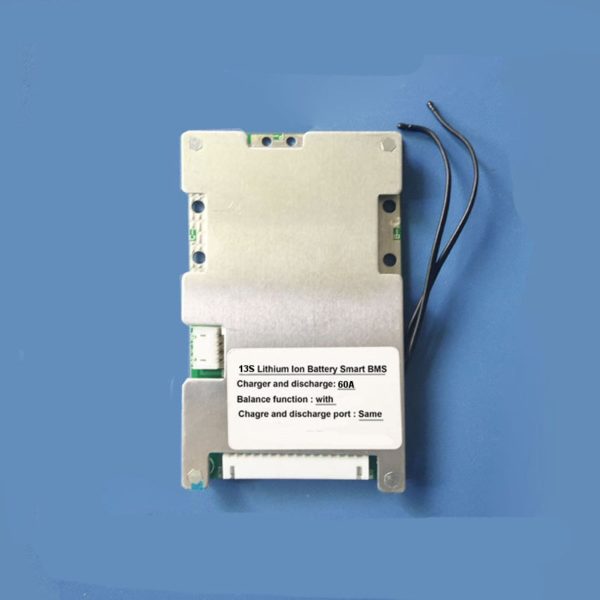 |
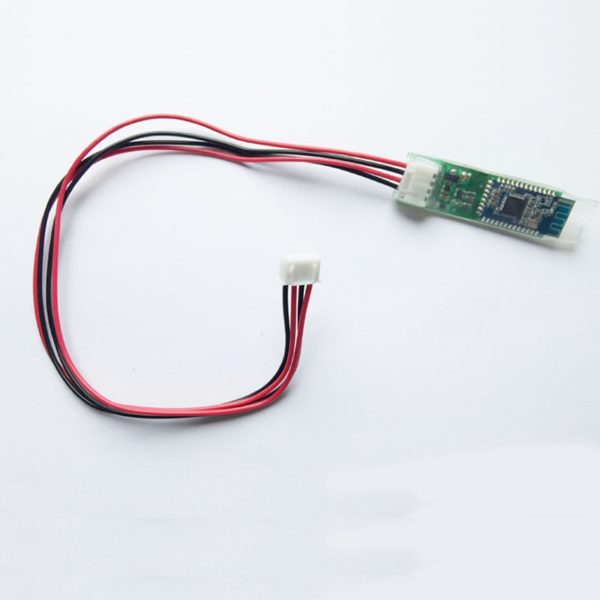 |
| 15S 60A Continuous BMS | Bluetooth addon |
This gave us 15 cells in series and 7 cells in parallel which gives us total of 105 cells.
We added 2 new cells in series to go from a 48v Nominal to 52v Nominal.
We have a 7p arrangement, so we have to add 14 new cells (2 lots of 7 cells in parallel).
The main reason for this is for faster recharge time, it also increases the longevity of the battery, as each cell is never charged to its maximum voltage.
Each cell is only charged to around 93.3% of its maximum voltage (58.8v / 63v = 93.33%)
There is a small loss in the capacity of the battery, due to the fact that we are charging each cell to 3.92v. We have also chosen a higher low voltage cut off of 3.2v (rather than 3.1v).
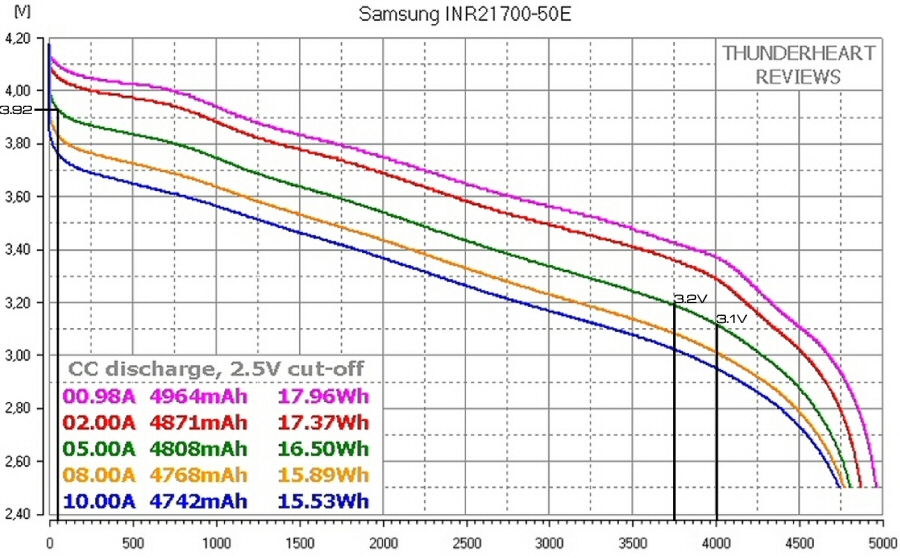
The data above is a modified graph from Thunderheart Reviews, a truly excellent review site of cells, please visit there website below.
The high cell voltage is 3.92v, so from the vertical line on the left of the graph is set at 3.92v and shows (on the horizontal axis) that we only loose 50 mAh from 4900mAh.
If we use a low voltage cut off of 3.1v (first vertical line on the left on graph) shows we loose 900mah from a total of 4900mAh. (4900mAh - 900mAh = 400mAh). If we add the capacity loss due to the 3.92v high voltage cut (50mAh) off we have 3950mAh remaining. This give us a total usable capacity of 27.65Ah (7 x 3950mAh).
We are using a low voltage cut off of 3.2v (second vertical line on the left on graph) shows we loose 1150mAh from a total of 4900mAh. (4900mAh - 1150mAh = 3750mAh per cell). If we add the capacity loss due to the 3.92v high voltage cut off we have 3700mAh remaining. This give us a total usable capacity of 25.9Ah (7 x 3700mAh).
The reason we are using a low cut off voltage of 3.2v is yet again to increase the longevity of the battery. If we need to we can have a reserve capacity of 1.75Ah.
There is one thing to bare in mind with this 1.75Ah, because we have changed from a 48v system to a 52v system.
When comparing batteries of different voltages we are better using what hours (Wh), because we will have more power due to the higher voltage of the 52v battery.
If we did the normal ratings for our 52v battery (as manufactures display them as), we would take the ratings for the cells from 4.2v to 2.5v, with a capacity of each cell being 5000mAh, we would get
The number of battery's in parallel (7P) x 5000mAh (5 Ah)
7 x 5Ah = 35Ah
For the nominal voltage they use
14 x 3.7v that would give 51.8v, but that would be rated as a 52v nominal battery
So when the watt hours are calculated we multiply the watt hours (Wh) by the nominal voltage
52v x 35Ah = 1820Wh !!!
In real world figure that are usable to roughly calculate how far we could get on an ebike.
This may also explain why you are getting less miles out of your battery. There are other factors than this but for simplification to we will stick to the battery.
To calculate the Watt hours (Wh), we multiply the nominal voltage by the number of Ah.
So in our 3.1v cut off
we have 51.8v (3.92v x 15) x 27.65Ah = 1432Wh approx.
and our 3.2v cut off
we have 51.8v (3.92v x 15) x 25.9Ah = 1341Wh approx.
Giving us a reserve of 91Wh (1432Wh - 1341Wh).
Our original 48v battery had a high cut off of 4.1v per cell and a low cut off voltage of 3.1v which gave us around 4050mAh per cell (4050mAh x 13) which is around 28.35Ah usable.
This would give us 28.35Ah which is higher than our new battery at both lower cut off voltages (27.65Ah and 25.9Ah).
If we do the calculation for we get 1363 Wh approximately.
(48v battery 1363Wh - 52v battery 1341Wh = 22Wh)
So with our new battery we have only lost 22 Wh in total even with the lower cell voltage ( and capacity loss), but have gained longevity of the battery. Longevity of the battery is as of yet undetermined but estimates are taking a normal battery life of 18 months to around 36 - 72+ months as a minimum.
Below is a table of selecting different cell low voltage cut off values, which displays the usable amp hours (Ah) and usable watt hours (Wh). This is based on the Samsung 21700 50e with a capacity of 4900maH each as stated on the datasheet. The watt hours are caluculated using a nominal voltage of 51.8v and multiplying it by the capacity of each cell and multiplying that value by 7(p).
| Low cell cuttoff voltage |
Usable amp hours (Ah) | Watt hours (Wh) |
| 3.2 | 25.9 | 1341 |
| 3.1 | 27.65 | 1432 |
| 3.0 | 29.75 | 1541 |
| 2.9 | 31.15 | 1613 |
| 2.8 | 31.85 | 1649 |
We bought another charger for a 63v maximum voltage system. We also upgraded the charger to 5A to charge faster, as our maximum charge rate is 35A. One thing to mention is don't switch on motor while charging, or the bafang display will show overvolt and shut the system down.
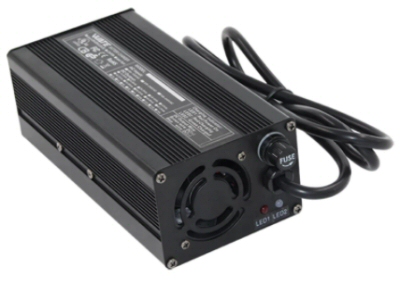
The graph below shows an approximation of the charging to 58.8v with a 5A charger.
The approximate charging time is aound 5.5 hours, 15s7p 29.5Ah (battery max voltage 58.8v, cell max voltage 3.92v). The graph assumes the low cut off voltage per cell is around 2.875v (40.25v), the charging will be less as our low voltage cut off per cell is 3.2v per cell.
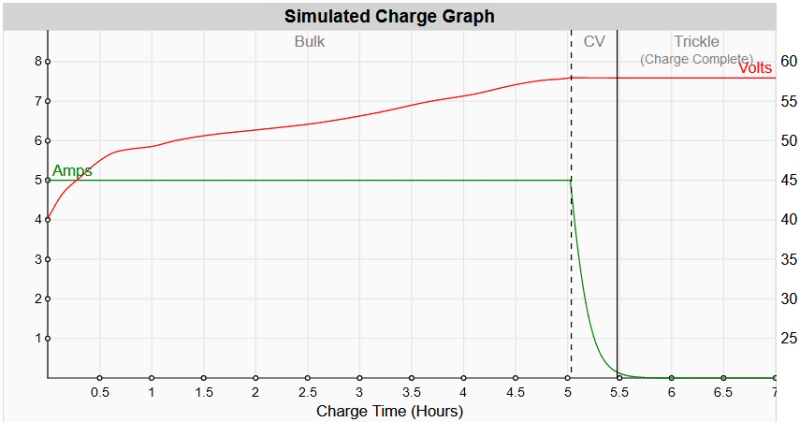

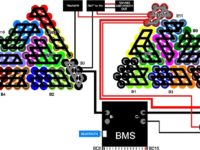

0 Responses